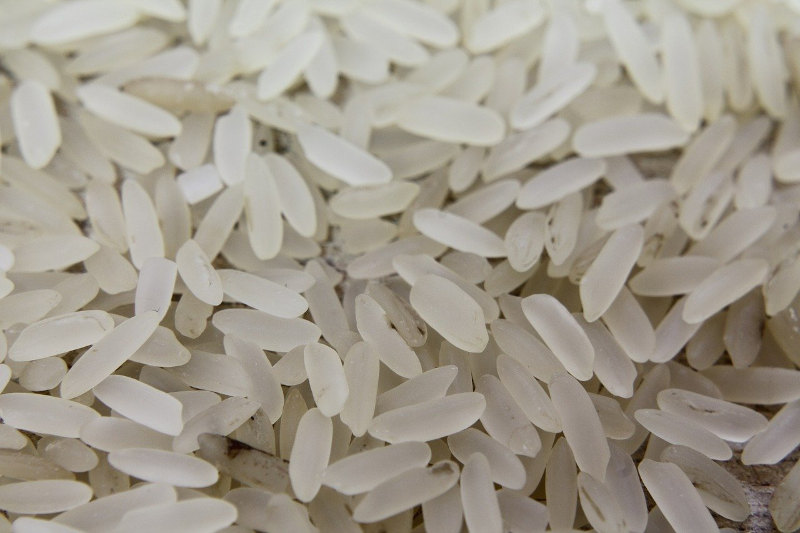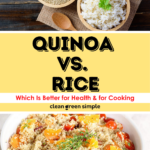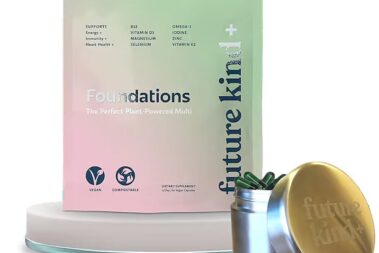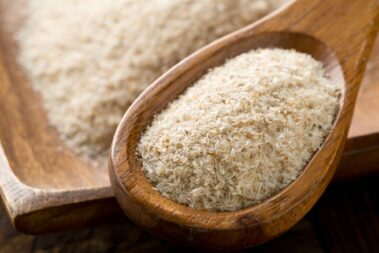Humans have been cultivating and eating rice for over 12,000 years. Even today, this staple food is the most popular grain eaten around the world with well over 400 million metric tons consumed per year.
But just because something is well-established and popular doesn’t necessarily mean it is the best out there. And when it comes to grains, there is one item, in particular, that is constantly being celebrated for its health benefits and culinary versatility.
And it isn’t rice. In fact, it’s not a grain at all!
So what exactly is quinoa and does it really live up to the hype? Let’s take a look at this up-and-coming grain crop and see just how well it stacks up against the current king of cereals.
Table of Contents
Quinoa: A Quick Introduction

Called “the mother grain” by the ancient Incans, quinoa has long been celebrated by native American peoples for its taste, spiritual power, and adaptability. Despite being so highly regarded and having been around for thousands of years, this ancient food has only recently gained superfood status throughout the world.
Quinoa Nutrition Information
While it is commonly considered a grain, quinoa is actually a seed from a plant closely related to beets and spinach. True gains come from grasses, but nutritionally speaking, both grains and low-fat seeds can be very similar.
Here is a quick break down of quinoa’s nutritional profile per 1 cup cooked:
- Total Calories: 222
- Total Carbs: 39g
- Total Sugar: 1g
- Fiber: 5g
- Protein: 8g
- Fat: 3.8g
- Iron: 2.7g
Quinoa Benefits
Because of the high fiber and protein content of quinoa, it has a relatively low glycemic index at about 53, making it a great choice for those predisposed to diabetes and those trying to lose weight. This power seed also provides all nine essential amino acids which means it is a great choice for vegans and vegetarians.
Quinoa also contains a host of minerals such as iron and antioxidants like quercetin, which has been shown to reduce inflammation and may even fight cancer. Anti-inflammatory properties along with a high fiber content also means that quinoa can help lower blood pressure and stabilize blood sugar levels.
Quinoa is high in vitamin B6 and insoluble fiber, is a good source for calcium, and has a low fat content. This means that this food a great choice for bone health and for reducing your chances of cardiovascular disease.
Side Note: There are many different types of quinoa, with each offering something a little bit different in terms of nutrition. Red and black quinoa have more antioxidants than white quinoa. The differences between quinoa types doesn’t have a huge impact of flavor or on the general health benefits of quinoa.
The Drawbacks of Quinoa
Quinoa is such a powerhouse of nutrition that it can be hard to find any flaws with it from a dietary standpoint.
But, the fact that it is considered a superfood does mean this cereal grain is more expensive than others. And, unlike rice, it does require some prep by soaking or rinsing to remove the bitter outer layer of saponin before cooking.
Delicious Quinoa Recipes
Brown Rice: A Quick Introduction

When we talk about rice that humans have been eating for thousands of years, we are talking about brown rice—which is simply the whole-grain form of the more modern staple, white rice.
Unlike white rice, brown rice still contains the nutritious germ and bran along with the starchy center. These retained pieces not only make brown rice nutritionally dense but also give it a noticeable chewy and nutty flavor.
Brown Rice Nutrition Information
While brown rice and white rice both contain about the same amount of sugar and starch, brown rice brings a lot more to the table.
Here is a quick look at the nutritional profile of brown rice based on one cup cooked:
- Total Calories: 216
- Total Carbs: 45g
- Total Sugar: 1g
- Fiber: 3.5g
- Protein: 5g
- Fat: 1.8g
- Iron: 0.8g
Brown Rice Benefits
In addition to providing plenty of fiber to aid in weight loss and helping you feel full, brown rice also contains plenty of vitamins and minerals to keep your body functioning the way it should. Like Quinoa, it is also packed with anti-inflammatory, disease-fighting antioxidants, especially phenols and flavonoids, two types of antioxidants that are very good at fighting oxidative stress.
Brown rice also tends to be inexpensive and available in bulk, which makes it a great choice for those on a budget.
The Drawbacks of Brown Rice
Compared to quinoa, brown rice has less protein and slightly more starch. Brown rice is also much lower in certain amino acids, such as lysine, and isn’t technically a complete protein on its own.
White Rice: A Quick Introduction

As the base of just about any American Chinese food order and a great substitute for wheat in gluten-free snacks, white rice has grown in popularity over the last century and a half. This sticky and familiar cereal grain is simply what is left when you remove the chewier bran and germ from the rice seed.
While it can’t touch quinoa or even brown rice in terms of nutritional value, white rice does have a taste and texture that is hard to dislike. And, because it is a simple starch, it’s uses in the culinary world are almost endless.
White Rice Nutrition Information
While white rice in its processed natural form is relatively devoid of nutrients compared to brown rice, it rarely hits the shelves this way. In fact, most white rice you will find at the grocery store or the local Chinese food joint has been enriched with synthetic vitamins and minerals.
Here is a quick look at the nutrient profile of one cup of cooked white rice:
- Total Calories: 194
- Total Carbs: 47g
- Total Sugar: 0.2g
- Fiber: 1.4g
- Protein: 4.6g
- Fat: 0.6g
- Iron: 0.4g for unenriched, 2.9g for enriched
White Rice Benefits
The bulk of the benefits of white rice have less to do with nutrition and more to do with how versatile this processed grain is.
With the bulk of the fiber removed, white rice has a creamy, soft texture that lends itself well to flours, desserts, and a wide range of savory and delicious culinary dishes. It’s this flexibility and pleasing texture that has led to more and more people opting for the processed version of this grain.
The Drawbacks of White Rice
While white rice has a relatively low amount of fat compared to brown rice and quinoa, it can actually be detrimental to weight loss and overall health given the lack of fiber content and higher glycemic index. And, even enriched forms do not provide near the same amount of vitamins, minerals, and antioxidants as whole grains and seeds.
Quinoa vs Brown Rice
If quinoa and brown rice are both packed with nutrition, which grain is actually better? This can be a difficult determination to make when talking in broad strokes. To truly choose a winner, we need to look deeper into the various ways one might want to rate each food.
Health Benefits
Both these tasty cereal grains are packed with their own unique profile of vitamins, minerals, and antioxidants. And both are known to aid in weight loss, reduce the frequency of certain diseases, such as diabetes, and help the body heal from within.
But, in terms of protein content and completeness, quinoa is the healthier option. Not only does it have more protein overall, but it provides all essential amino acids on its own. It also contains more fiber than brown rice, which not only aids in digestion but can help keep you feeling fuller longer.
Quinoa is also the top performer when looking at important available minerals like iron and folate. These are especially important micronutrients for women and people eating a plant-based diet.
Side Note: If you’re looking to add more nutrition to your plate but want to stick to rice, there are other types of rice to consider. Wild rice is the most nutritionally dense of any rice type. Pigmented rice varieties, which includes red rice and black rice, also have more to offer than standard brown rice.
Taste
In terms of taste, both these grains have a bit of a nutty flavor.
Quinoa is much smaller than rice and has quite a different texture. It isn’t necessarily a grain you need to chew, which can detract some from the eating experience. Brown rice, on the other hand, is more substantial and has a pleasant, chewy texture.
While both these grains tend to get mushy if overcooked, it is more difficult to overcook quinoa. But, quinoa does require rinsing before cooking to remove the natural bitter taste. If you skip this step, the result can be noticeable and unpleasant.
Culinary Use
Both of these cereal grains can be used in a wide variety of dishes, from sweet to savory. Quinoa and brown rice are fairly interchangeable within recipes as well, though you can expect a slight texture change.
In terms of home cooking, quinoa takes much less time to prepare at about 20 minutes compared to 45 for brown rice. This can make it a better choice for weeknight dinners or last-minute meal prep.
Overall, the taste and texture of brown rice may be more familiar in traditional dishes than quinoa, but both can easily be incorporated into a wide range of meals and interchanged to put a new spin on an old classic. If you are feeling extra adventurous, you can even mix the two for a grain-based dish that is as visually pleasing as it is tasty.
Quinoa vs White Rice
When it comes to quinoa verse brown rice’s more processed cousin, white rice, there is no real contest in terms of health. But that doesn’t mean quinoa is a shoo-in to win the categories of taste and culinary use.
Health Benefits
Here, quinoa is a clear winner. In fact, any whole grain, including brown rice, is going to knock white rice out of the park if all you are considering is nutritional value.
In addition to being relatively devoid of natural vitamins and minerals, white rice just does not bring that much to the table in terms of protein, fiber, or even healthy fat. It is made up almost entirely of simple starches that break down quickly in the gut and cause blood sugars to rise fast.
White rice is also a highly processed food as far as grains go, meaning that it is a far cry from the natural grains and seeds our digestive tracts have evolved to process. This may be one reason why white rice is so closely linked with metabolic disorders like diabetes and weight problems.
Taste
The competition gets a little murkier when you try to compare the taste of these two foods simply because they are so different. While quinoa and brown rice share some similar flavor features and white rice and brown rice do as well, quinoa and white rice are just too far removed from one another.
While quinoa has a sort of nutty, almost sesame flavor, white rice tastes like pure, simple starch. It has a very mild flavor that is easily influenced by whatever other flavors are in the dish. And this is one reason it is so popular.
The texture of the two is also very different, with even al dente white rice having a smoother, squishier feel than quinoa.
Culinary Use
It’s that very simple flavor and mutable texture that make white rice so popular in the culinary field.
If the star of the dish is meant to be the spices or another ingredient, white rice is a great supporting character since it will never overshadow the other foods in the recipe. This is very different from quinoa, which tends to attract a lot of attention, both for its taste and texture.
While both of these grains are gluten-free, the versatility of white rice when made into flour also gives it a leg up when it comes to cooking gluten and wheat-free meals. However, it is now easier to find quinoa flour and quinoa flakes, both of which can be used easily in gluten-free baking.
As far as use in your own kitchen, both these foods take about the same amount of time to cook. Both are easy to prepare and store, as well.
Overall, white rice will likely always hold a place in the culinary world for its mild taste and wide-ranging uses, but quinoa is a much better substitute if your focus is on health and nutrition.
And the Winner Is…
In the end, quinoa really does live up to the hype. It is a versatile, tasty seed packed with nutrients and protein that deserves a place in your healthy diet. But brown rice deserves an honorable mention for its own health benefits and does not need to be replaced entirely by quinoa in your pantry.
White rice, on the other hand, should find its way out of your kitchen if your goal is to eat healthier, lose weight, or just plain feel better. Or, at the very least, save it for those few special recipes where only the starchy goodness of white rice will do.
- How to Pick the Perfect Watermelon For a Sweet Summer Treat - April 10, 2024
- Future Kind’s Foundations: A Multivitamin Made for Vegans - December 5, 2023
- Does Nutritional Yeast Go Bad? - November 28, 2023








